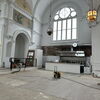Where to save energy costs in your business
Saving energy is all about saving green.
Here's an interesting exercise. Stop reading for a moment and look around you. Think of all the appliances, fixtures, electronic components and machinery operating right now. To a greater or lesser extent, that energy is a trickle of money affecting someone's bottom line.
And it adds up quickly, even when you operate a modest-sized business. Every computer and monitor that is more than four years old may cost you just over $100 a year to power up. The office coffee maker? If you have a 1,500-watt unit, it will cost over $450 a year.
To satisfy your soda fix, that 400-watt soda vending machine might cost the company more than $500 a year to operate. If your lunch room has a standard-size refrigerator, there's another $400 or so annually.
Then, there's the worker whose cubicle gets icy cold. On goes the space heater — a considerable energy hog at more than $400 a year per 1,500-watt unit — for the first six months of the year.
In this world of tighter operating budgets, and with a growing body of science about energy-management technology, more businesses are taking energy efficiency seriously. The U.S. Environmental Protection Agency estimates that if the energy efficiency of commercial and industrial buildings improved by 10%, Americans would collectively save about $20 billion and reduce greenhouse gas emissions equal to the emissions from almost 30 million vehicles.
It's no surprise that most companies start the process by looking at their lighting costs. After all, it's everywhere and nearly always on. Next to conservation, lighting is often one of the easiest and most cost-effective measures to take, according to Bruce Harrington of Energy & Resource Solutions, an energy engineering and consulting firm. By replacing incandescent bulbs with compact fluorescents you'll use about 75% less energy, and CFLs last up to 10 times as long, saving on replacement costs and labor. Light-emitting diodes, or LEDs, last even longer and are even more efficient, although more expensive. Replacing older linear tube florescent lamps that are prevalent in most office spaces with more energy efficient lamps is also very cost effective.
"For older buildings, lighting is one of the low-hanging fruit," says Harrington. "That's particularly true of buildings with long hours of operation."
In restrooms and supply closets, many companies have turned to occupancy sensors and timers. However, Harrington and others in the industry advise that companies may want to do more than simply replace every inefficient fixture with an efficient one and add controls. "The first step is to undertake an office lighting redesign," explains Harrington. "Rather than replacing fixtures one-for-one, look at the space anew and consider what it really needs in terms of lighting. Task lighting at work stations is often more effective than overlighting the whole space..."
Here's how to do it:
- Get help
For a company that wants to get serious about energy efficiency, Harrington and others suggest hiring a professional energy adviser or auditor to conduct an energy assessment. He or she should assess a facility's lighting systems, manufacturing or processing components, heating/ventilation/air conditioning systems, refrigeration systems and office equipment to identify opportunities for energy savings. The next step is to flesh out those opportunities to determine the return on investment for various upgrades.
The cost of getting an energy assessment runs the gamut of a few hundred dollars for a basic "walk-through" assessment at a small business operation, to several thousand dollars for a larger manufacturing facility.
- Make a plan
Next, you should create an energy management plan — a multi-year strategy to save energy and money. One way to do that is to benchmark your facility against others of comparable size, according to Rick Meinking, Efficiency Maine's business program manager. Energy Star, best known as a label for appliances and products that meet strict energy efficiency guidelines set by the EPA and the Department of Energy, also identifies superior energy performance for America's commercial and industrial buildings.
"An energy plan provides the foundation for successful energy management," says Meinking. "It ensures that everyone in the organization is on the same page — everyone on the team knows what the game plan is. It also formalizes senior management's support and articulates the organization's commitment to energy efficiency for employees, the community and other stakeholders."
- Review your HVAC
Next to lighting, the next most common place to find energy savings is with HVAC systems. Energy efficient heating and ventilation systems have come a long way, to be sure. However, savings can often be found in what is called retro-commissioning, which consists of re-calibrating the controls that automatically regulate heating, cooling and lighting systems.
"Typically, a company may have purchased a heating and cooling system that is automatically controlled through an energy management system that regulates the operation over the course of a work week," says Harrington. "There are times when the system isn't 'commissioned' or tested upon installation to ensure it is operating within the original design parameters. There are other times when the controls are changed due to individual employee comfort levels and the HVAC system may be cooling and heating the space simultaneously. Having the system professionally recalibrated back to its original design specifications can save significant amounts of energy and have very quick paybacks."
- Finding the money
One major barrier to making many of these energy upgrades is the up-front financial investment in energy efficient equipment, often difficult for a small company. In 2011, the Efficiency Maine Business Program provided customers with $6.5 million in cash incentives for energy upgrades, leveraging $10.1 million in private investments.
Companies can take advantage of incentives for prescriptive and custom energy efficiency measures. For example, certain high-efficiency fluorescent retrofits might be eligible for $35 per fixture. Prescriptive incentives are offered for lighting, refrigeration, HVAC, variable frequency drives, natural gas upgrades and agricultural measures. In addition, anything that produces cost-effective electrical savings can be considered for a custom incentive.
Through its Qualified Partner program, companies can find contractors who can perform energy upgrades and are specially trained to help companies take advantage of Efficiency Maine's many incentives and programs. (Visit us at www.efficiencymaine.com.)
With new LED technology, for example, significant savings can be achieved by replacing inefficient outdoor metal halide and high-pressure sodium lights with LED lighting, which lasts much longer and reduces maintenance and replacement costs. A Qualified Partner selected by a business would then help identify the proper energy-efficient equipment, apply for the Efficiency Maine incentive and install the qualifying components.
- Help for new construction
Efficiency Maine also offers incentives for commercial new construction that meets certain energy-efficiency guidelines. If you're building a new commercial building, energy-efficiency features offer many benefits, including savings year after year on heating and electric bills, greater comfort for employees and lower maintenance costs.
For example, Efficiency Maine's Maine Advanced Buildings Program is one option for commercial new construction that offers strategies and incentives to help Maine owner-builders, developers, architects and engineers design buildings that are 15-20% more energy efficient than the MABUC requires. Advanced Buildings is a national program to raise the standards for energy efficiency in commercial construction. Efficiency Maine adopted these strategies and customized them to Maine's climate and building styles, and provides the local support and incentives to help Maine companies participate.
- Own it
For efficiency to work long-term, Harrington and Meinking suggest finding a champion within the organization. "You need someone who understands the benefits of energy efficiency, grasps the concept of cash flow, and has the ear of the CFO or CEO," he says.










Comments